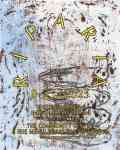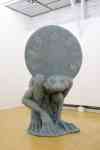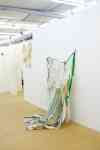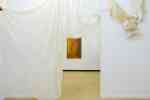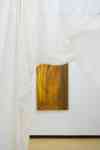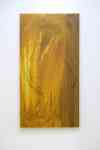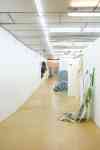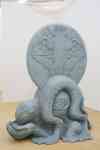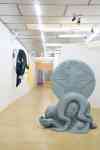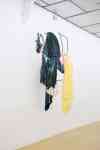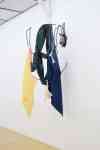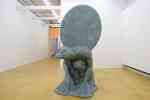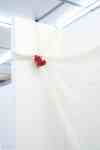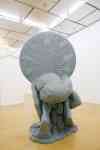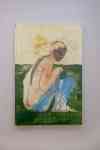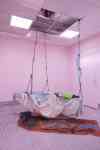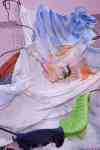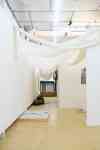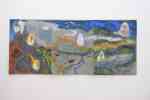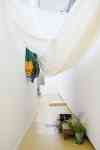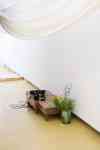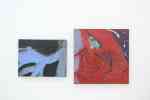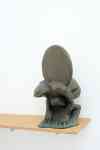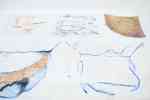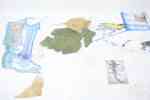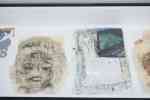
The Community is pleased to announce Riparia, an exhibition pairing new works of the artists Frederik Exner and Inès Di Folco Djemni, in collaboration with Caroline Curdy.
The show focuses on the two artists’ research and interrogations around the notion of a river, understanding it as a space that is at once cultural and symbolic, tangible yet mystical. Exner and Di Folco Djemni will exhibit in Riparia a series of new, commissioned works - sculptures, paintings on silk, music, drawings and sketches. In the exhibition, the river acts as a meeting point between the artists, whilst in real life, Di Folco Djemni and Exner have shared their atelier space in the north of Paris since 2022. Riparia is the first time the two artists collaborate on a shared exhibition project.
Riparia, borrowed from the Latin word riparius, referring to a riverbank or a stream, is an exhibition based on a research project initiated by Di Folco Djemni and Exner in 2021. The artists approach the idea of the river as a sort of container that holds ideas and images, myths and narratives across histories and civilizations. Through their artistic research process, the river turns into a cultural, social and imaginary space with a myriad of references. Travelling across the African Middle Ages, Afro-Cuban history and the current global ecological crisis, the exhibition brings together the artists’ respective practices and queries, and their interest in various subject matters, such as religious music, the history of the silk industry, ancient myths and amphibious beings. Exploring several fictional and tangible rivers through poetry, scientific writings, botanic, metal, folklore, critical theory and indigenous knowledge, Di Folco Djemni and Exner create an exhibition that features the river’s multifarious poetic layers. Through their work, they draw attention to the material conditions and exploitation of the rivers in today’s context, and ask questions related to the resistance and resilience of flora and fauna.
When first entering the exhibition space, the visitor is greeted by the large-scale amphibious sculptures made by Frederik Exner. The works stem from his long-time interest and research in the personification of the non-human, and his questioning of the hierarchy between humans and non-humans. Lately, Exner has been interested in amphibians and especially the porosity of their viscous skin-breathing bodies. Frogs and salamanders lay shell-less eggs directly in rivers and lakes and thus use the waters as surrogate mothers. Furthermore, the number of tales about metamorphosis between frogs and humans, and creation myths where humans’ existence stem from toads seem to indicate a primordial and ambivalent connection between humans and these ancient animals.
Exner’s work is set in dialogue with three new sculptural paintings on silk by Inès Di Folco Djemni. The paintings are made in collaboration with artist Caroline Curdy, resulting from a long conversation between the two artists. The works illustrate Di Folco Djemni’s recent experimentation with painterly and collaborative practices and her strong connection and exploration of heritage and narratives, both personal and collective. The shapes and colours of these works respond to Exner’s sculptures, and the tension of the steel frames creates a contrast when coming together with the tenderness of silk. In Riparia, Caroline Curdy uses sculpture as a means to create a meeting point between the canvas and the frame, which simultaneously holds and hosts the pictorial matter. The frames, made out of steel, become a three-dimensional pencil line in the exhibition space. Across different mediums, fabric, glass, food, and forging, Curdy questions through her practice and gesture forms that are defined, yet always in a movement.
The sculptural pieces in the exhibition space are accompanied by Di Folco Djemni’s new sound experimentation, Rio Camina, which brings together a myriad of references such as her band Rose Mercie, field recordings, Santería, polyphonic percussions and voices, trance and water cycles, which find themselves transposed in contemporary Afro-Cuban context. The music was recorded in October 2022, and conceived in collaboration with French and Cuban musicians, who are Di Folco Djemni’s teachers and close friends: Emmanuel Colombani and Lazaro Bangela Carreras, RV Joelle and Cyril Harrison.
The last part of the exhibition features Exner’s and Di Folco Djemni’s drawings and sketches connected to Riparia’s research process between 2021-2023. Together the artists create an exhibition featuring an interwoven web of references to nature and the invisible, where the constant flow of water and its cyclicality creates a thread guiding the visitor through the exhibition.
The exhibition is supported by Mondes nouveaux.
www.frederikexner.dk
www.sissi-club.com/ines-difolco
www.instagram.com/carolinerosecurdy
